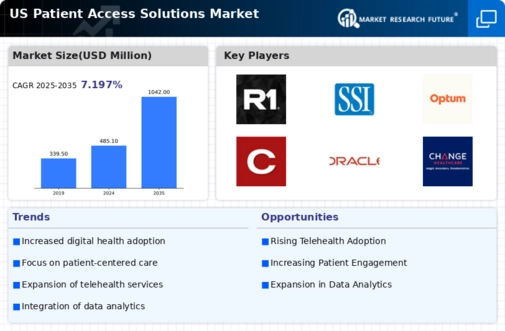Regulatory Support for Enhanced Patient Access
Regulatory frameworks in the US are evolving to support enhanced patient access to healthcare services. Initiatives aimed at reducing barriers to care, such as the implementation of the Affordable Care Act, have contributed to a more favorable environment for patient access-solutions market growth. These regulations encourage healthcare providers to adopt technologies that improve patient engagement and streamline access to services. For instance, the Centers for Medicare & Medicaid Services (CMS) has introduced measures that incentivize the use of telehealth and other access solutions, potentially increasing market value by an estimated 15% over the next few years.
Rising Demand for Convenient Healthcare Access
The patient access-solutions market is experiencing a notable surge in demand for convenient healthcare access. Patients increasingly seek solutions that facilitate easier scheduling, communication, and overall engagement with healthcare providers. This trend is driven by a growing awareness of the importance of timely medical attention and the desire for streamlined processes. According to recent data, approximately 70% of patients express a preference for digital tools that enhance their access to healthcare services. As a result, healthcare organizations are investing in patient access solutions to meet these expectations, thereby driving growth in the market.
Growing Emphasis on Patient-Centric Care Models
The shift towards patient-centric care models is significantly influencing the patient access-solutions market. Healthcare providers are increasingly recognizing the importance of tailoring services to meet individual patient needs. This approach fosters better patient engagement and satisfaction, which are critical for successful healthcare outcomes. As a result, organizations are adopting access solutions that prioritize patient preferences and feedback. Research indicates that patient-centric models can lead to a 20% increase in patient retention rates, thereby underscoring the potential for growth in the patient access-solutions market as providers align their strategies with this trend.
Technological Advancements in Healthcare Delivery
Technological advancements are playing a pivotal role in shaping the patient access-solutions market. Innovations such as mobile applications, online appointment scheduling, and electronic health records are transforming how patients interact with healthcare systems. These technologies not only enhance patient experience but also improve operational efficiency for providers. The market is projected to grow at a compound annual growth rate (CAGR) of 12% through 2028, driven by the increasing integration of technology in healthcare delivery. As these advancements continue to evolve, they are likely to further expand the capabilities of patient access solutions.
Increased Focus on Health Equity and Accessibility
The patient access-solutions market is also being driven by a heightened focus on health equity and accessibility. There is a growing recognition of the disparities in healthcare access among different populations, prompting initiatives aimed at addressing these gaps. Organizations are developing solutions that cater to underserved communities, ensuring that all patients have equitable access to healthcare services. This commitment to health equity is likely to expand the market, as it aligns with broader societal goals of inclusivity and fairness in healthcare delivery. Efforts to improve access for marginalized groups could potentially increase market participation by 10% in the coming years.























Leave a Comment